Salby M.L. Fundamentals of Atmospheric Physics
Подождите немного. Документ загружается.

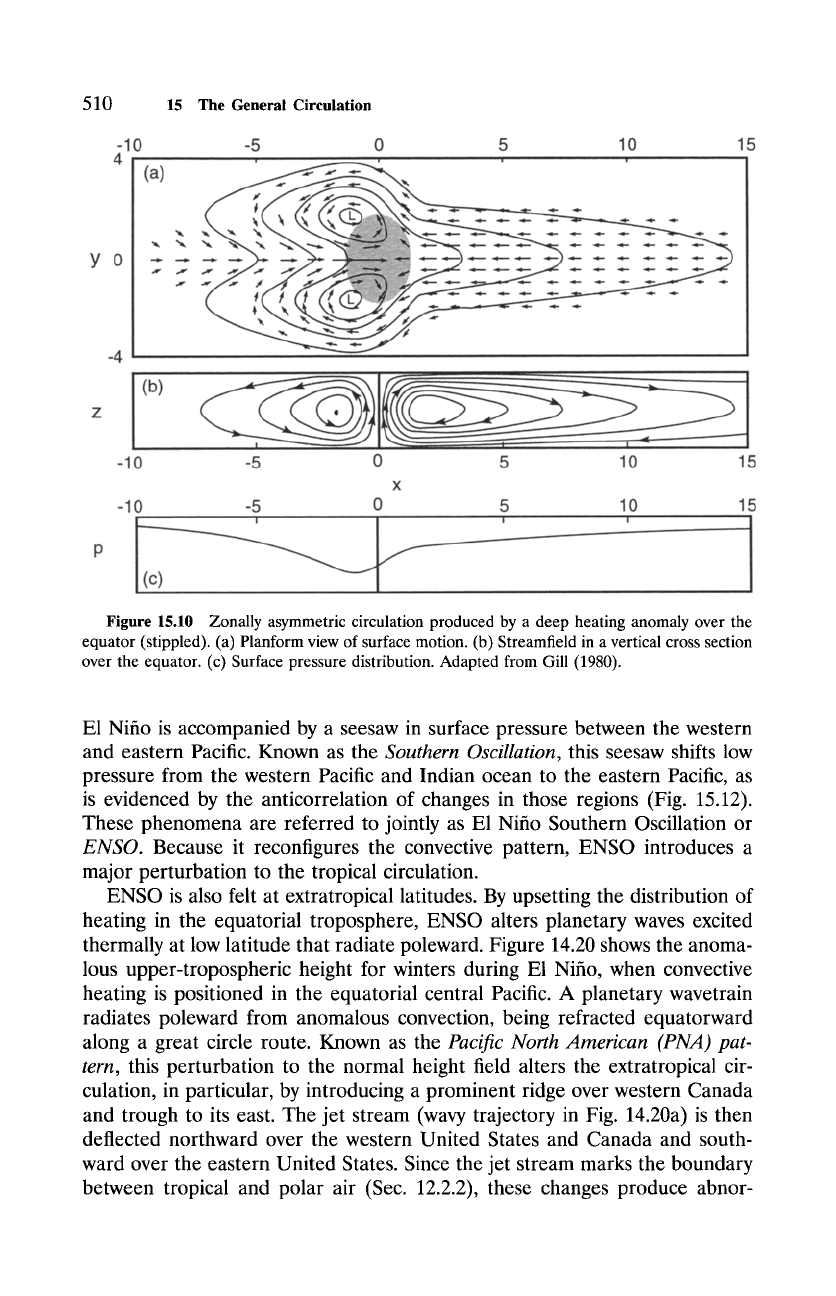
510
15 The General Circulation
-10
4
y o
-4
-5 0 5 10 15
-10 -5 0
x
-10 -5 0 5 10
I ~ I I
(el
5 10 15
15
I
Figure
15.10 Zonally asymmetric circulation produced by a deep heating anomaly over the
equator (stippled). (a) Planform view of surface motion. (b) Streamfield in a vertical cross section
over the equator. (c) Surface pressure distribution. Adapted from Gill (1980).
E1 Nifio is accompanied by a seesaw in surface pressure between the western
and eastern Pacific. Known as the
Southern Oscillation, this seesaw shifts low
pressure from the western Pacific and Indian ocean to the eastern Pacific, as
is evidenced by the anticorrelation of changes in those regions (Fig. 15.12).
These phenomena are referred to jointly as E1 Nifio Southern Oscillation or
ENSO. Because it reconfigures the convective pattern, ENSO introduces a
major perturbation to the tropical circulation.
ENSO is also felt at extratropical latitudes. By upsetting the distribution of
heating in the equatorial troposphere, ENSO alters planetary waves excited
thermally at low latitude that radiate poleward. Figure 14.20 shows the anoma-
lous upper-tropospheric height for winters during E1 Nifio, when convective
heating is positioned in the equatorial central Pacific. A planetary wavetrain
radiates poleward from anomalous convection, being refracted equatorward
along a great circle route. Known as the
Pacific North American (PNA) pat-
tern,
this perturbation to the normal height field alters the extratropical cir-
culation, in particular, by introducing a prominent ridge over western Canada
and trough to its east. The jet stream (wavy trajectory in Fig. 14.20a) is then
deflected northward over the western United States and Canada and south-
ward over the eastern United States. Since the jet stream marks the boundary
between tropical and polar air (Sec. 12.2.2), these changes produce abnor-
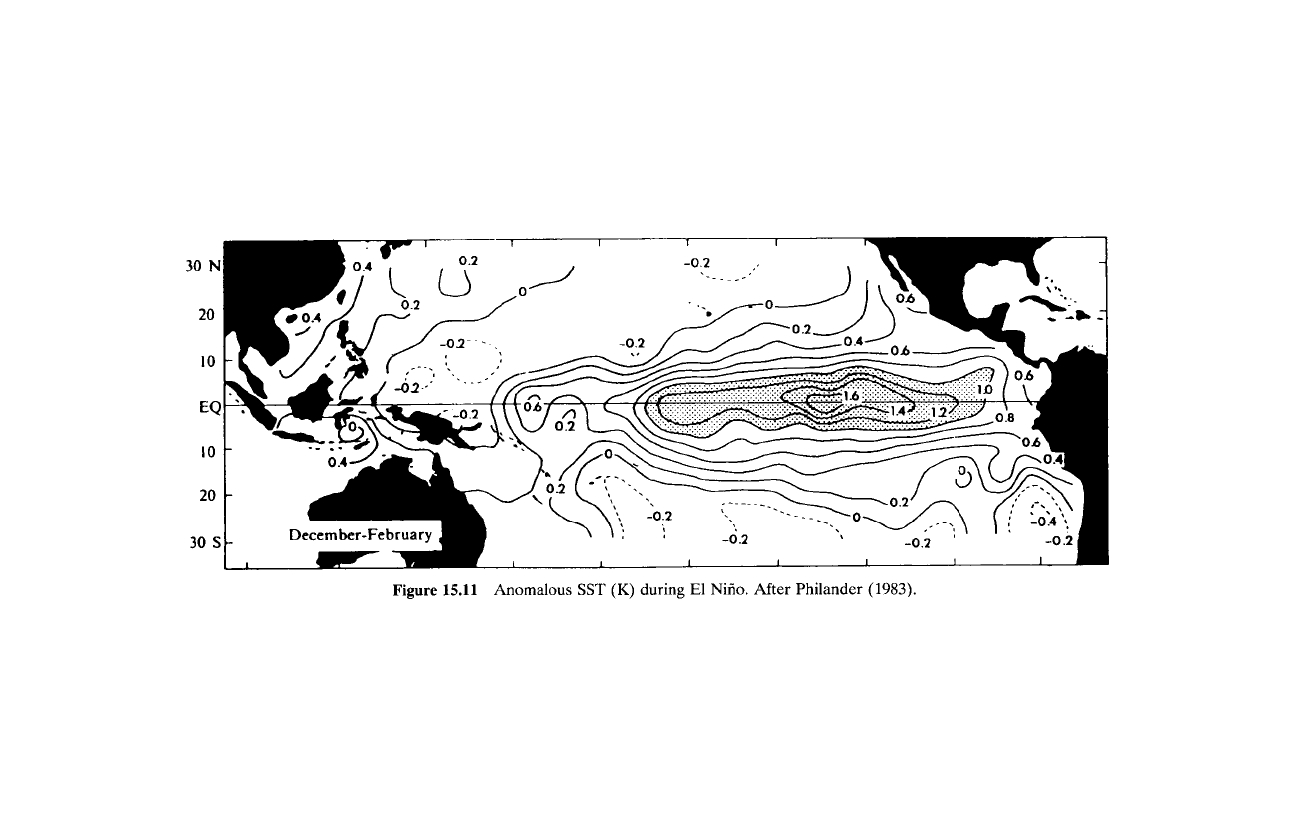
Figure
15.11
Anomalous
SST
(K)
during
El
Nifio.
After Philander
(1983).
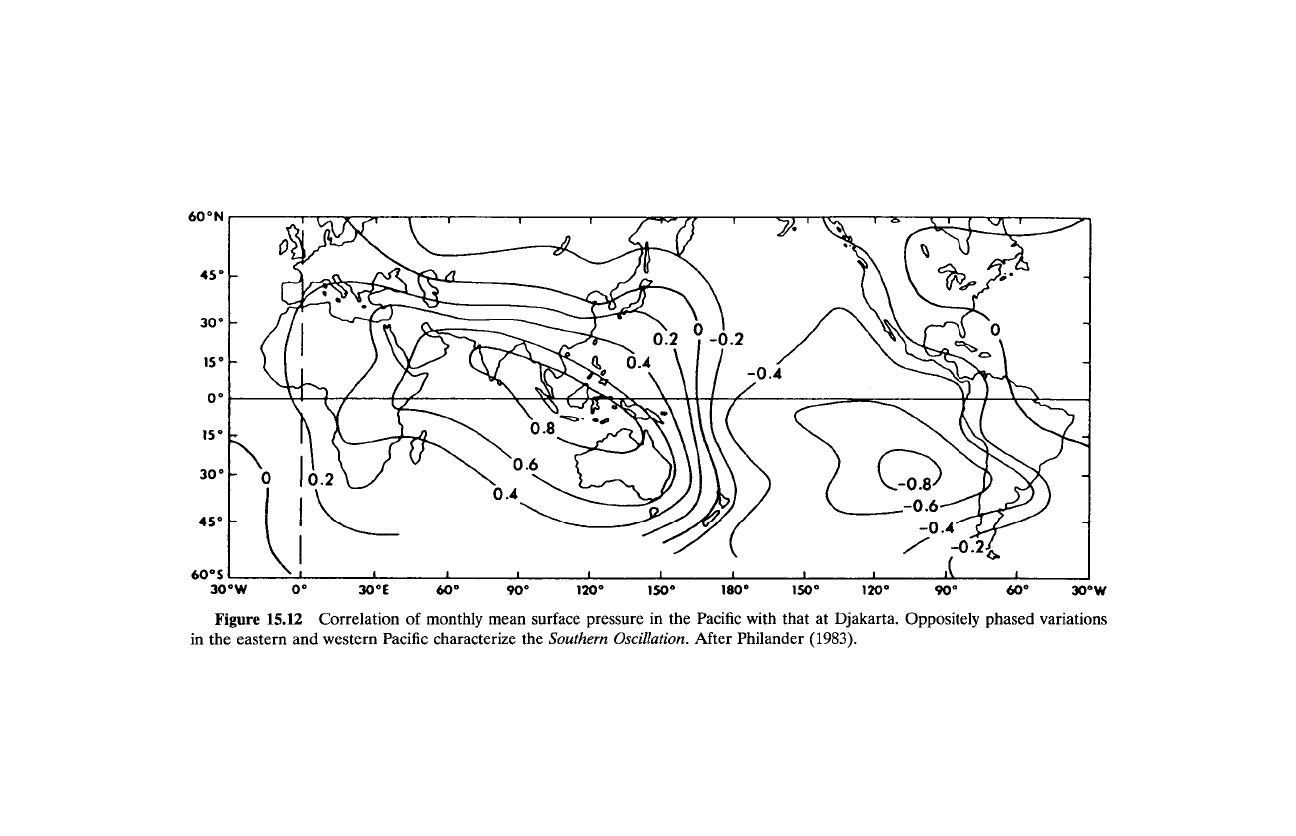
~
3OoW
0"
30OE
60"
90"
1200
1500
1800
ls00
1200
900
60O
mow
Figure
15.12
Correlation of monthly mean surface pressure in the Pacific with that at Djakarta. Oppositely phased variations
in the eastern and western Pacific characterize the
Southern Oscillation.
After Philander
(1983).
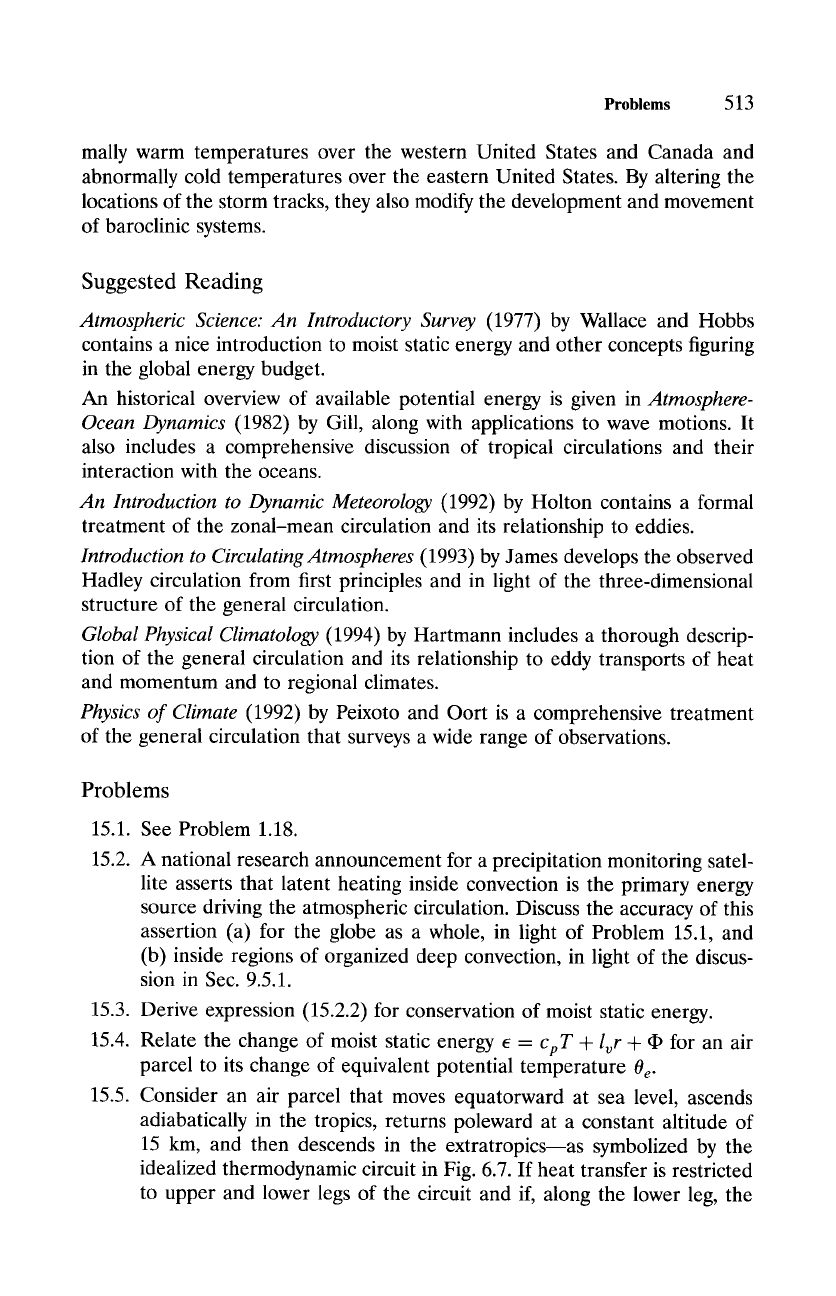
Problems 513
mally warm temperatures over the western United States and Canada and
abnormally cold temperatures over the eastern United States. By altering the
locations of the storm tracks, they also modify the development and movement
of baroclinic systems.
Suggested Reading
Atmospheric Science: An Introductory Survey
(1977) by Wallace and Hobbs
contains a nice introduction to moist static energy and other concepts figuring
in the global energy budget.
An historical overview of available potential energy is given in
Atmosphere-
Ocean Dynamics
(1982) by Gill, along with applications to wave motions. It
also includes a comprehensive discussion of tropical circulations and their
interaction with the oceans.
An Introduction to Dynamic Meteorology
(1992) by Holton contains a formal
treatment of the zonal-mean circulation and its relationship to eddies.
Introduction to Circulating Atmospheres
(1993) by James develops the observed
Hadley circulation from first principles and in light of the three-dimensional
structure of the general circulation.
Global Physical Climatology
(1994) by Hartmann includes a thorough descrip-
tion of the general circulation and its relationship to eddy transports of heat
and momentum and to regional climates.
Physics of Climate
(1992) by Peixoto and Oort is a comprehensive treatment
of the general circulation that surveys a wide range of observations.
Problems
15.1.
15.2.
15.3.
15.4.
15.5.
See Problem 1.18.
A national research announcement for a precipitation monitoring satel-
lite asserts that latent heating inside convection is the primary energy
source driving the atmospheric circulation. Discuss the accuracy of this
assertion (a) for the globe as a whole, in light of Problem 15.1, and
(b) inside regions of organized deep convection, in light of the discus-
sion in Sec. 9.5.1.
Derive expression (15.2.2) for conservation of moist static energy.
Relate the change of moist static energy E -
cpT + l~r + d~
for an air
parcel to its change of equivalent potential temperature 0e.
Consider an air parcel that moves equatorward at sea level, ascends
adiabatically in the tropics, returns poleward at a constant altitude of
15 km, and then descends in the extratropicsmas symbolized by the
idealized thermodynamic circuit in Fig. 6.7. If heat transfer is restricted
to upper and lower legs of the circuit and if, along the lower leg, the
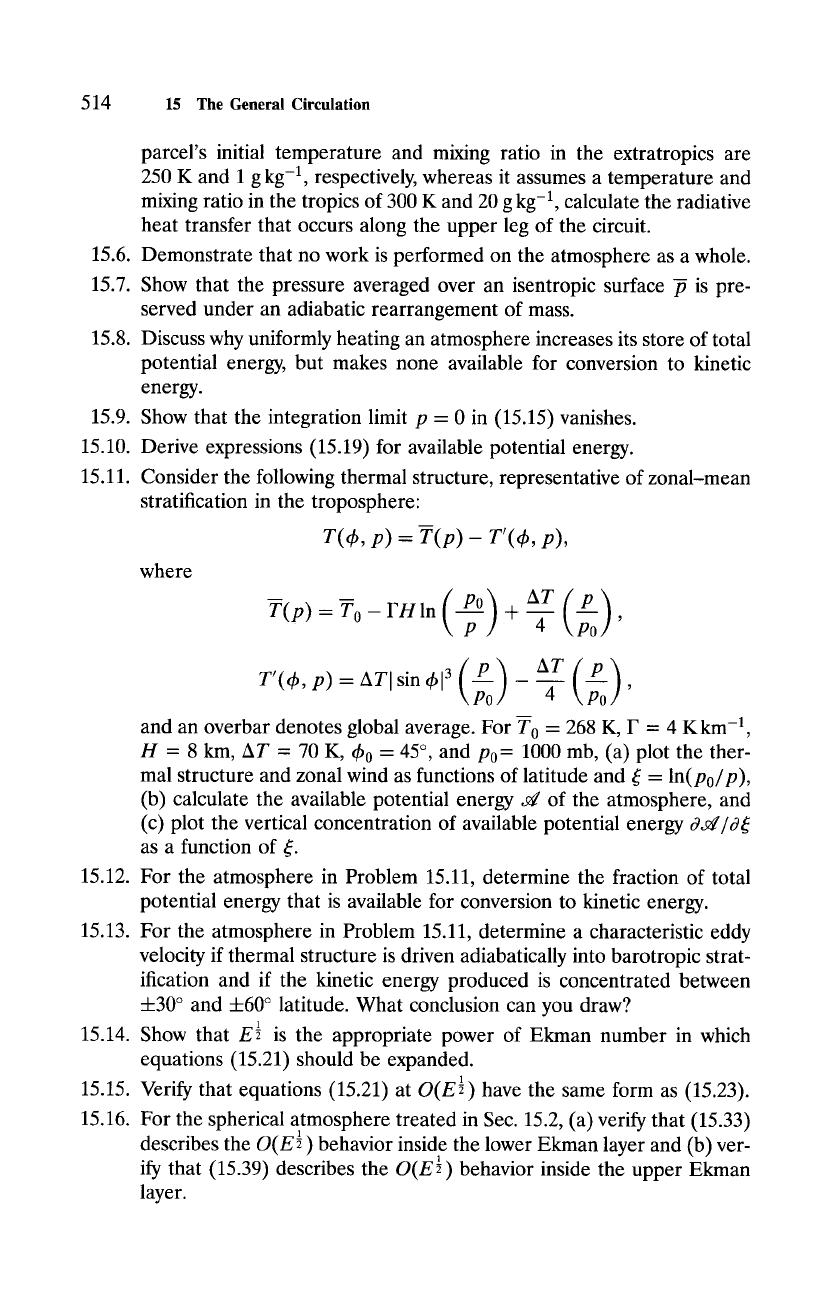
514
15 The General Circulation
parcel's initial temperature and mixing ratio in the extratropics are
250 K and 1 g kg -1, respectively, whereas it assumes a temperature and
mixing ratio in the tropics of 300 K and 20 g kg -1, calculate the radiative
heat transfer that occurs along the upper leg of the circuit.
15.6. Demonstrate that no work is performed on the atmosphere as a whole.
15.7. Show that the pressure averaged over an isentropic surface ff is pre-
served under an adiabatic rearrangement of mass.
15.8. Discuss why uniformly heating an atmosphere increases its store of total
potential energy, but makes none available for conversion to kinetic
energy.
15.9. Show that the integration limit p - 0 in (15.15) vanishes.
15.10. Derive expressions (15.19) for available potential energy.
15.11. Consider the following thermal structure, representative of zonal-mean
stratification in the troposphere:
T(th, p)=
T(p)-
T'(th, p),
where
T(p)= T0-rHln --p- + P0 '
T,(ch p ) _ A T [sinch la ( P ) A__~~ ( p )
' To- To'
and an overbar denotes global average. For T O - 268 K, F - 4 Kkm -1,
H = 8 km, AT = 70 K, 4,0 - 45 ~ and P0- 1000 mb, (a) plot the ther-
mal structure and zonal wind as functions of latitude and ~ -
ln(po/p),
(b) calculate the available potential energy d of the atmosphere, and
(c) plot the vertical concentration of available potential energy ?d/?~
as a function of ~.
15.12. For the atmosphere in Problem 15.11, determine the fraction of total
potential energy that is available for conversion to kinetic energy.
15.13. For the atmosphere in Problem 15.11, determine a characteristic eddy
velocity if thermal structure is driven adiabatically into barotropic strat-
ification and if the kinetic energy produced is concentrated between
4-30 ~ and +60 ~ latitude. What conclusion can you draw?
15.14. Show that E89 is the appropriate power of Ekman number in which
equations (15.21) should be expanded.
15.15. Verify that equations (15.21) at
O(E89
have the same form as (15.23).
15.16. For the spherical atmosphere treated in Sec. 15.2, (a) verify that (15.33)
describes the
O(E89 )
behavior inside the lower Ekman layer and (b) ver-
ify that (15.39) describes the
O(E89 )
behavior inside the upper Ekman
layer.
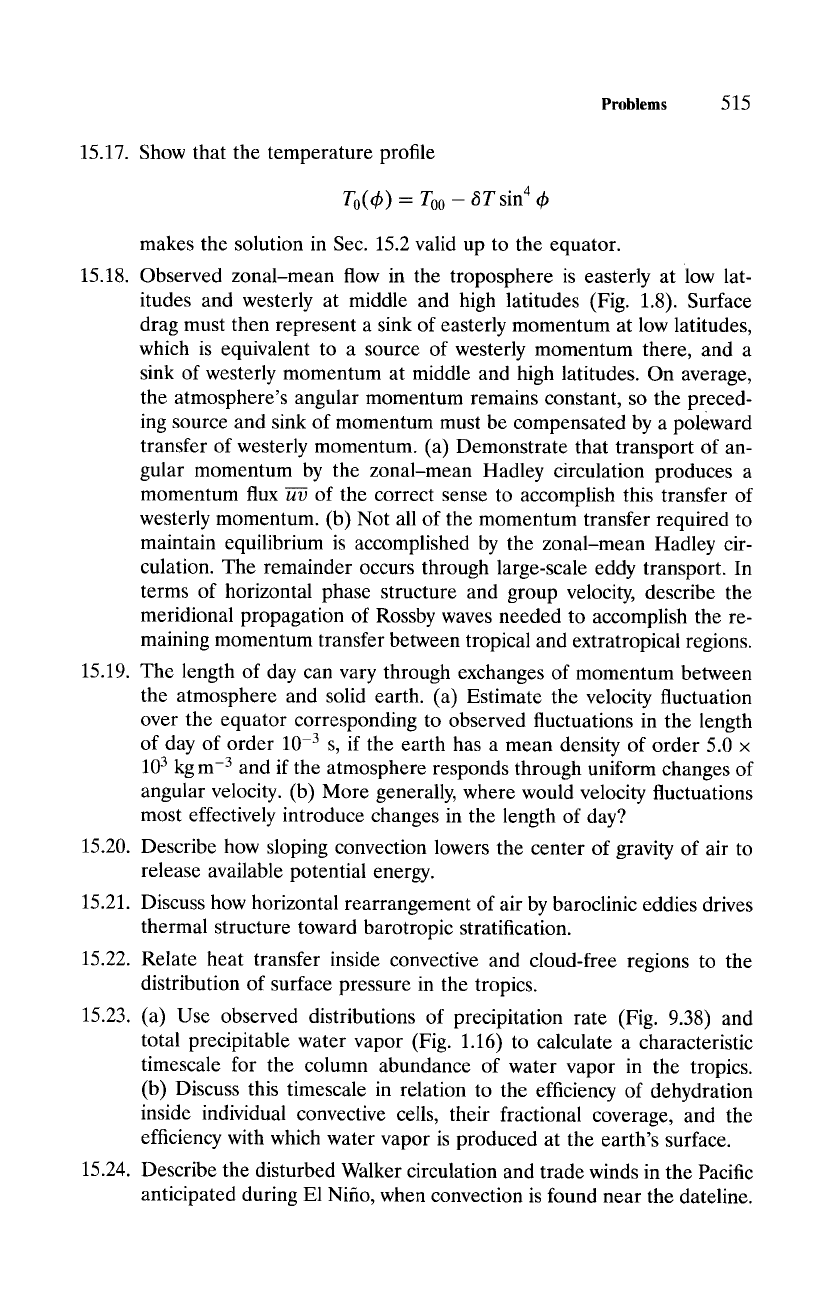
Problems
515
15.17. Show that the temperature profile
To(b) - Too - 6Tsin 4 ~b
15.18.
15.19.
15.20.
15.21.
15.22.
15.23.
15.24.
makes the solution in Sec. 15.2 valid up to the equator.
Observed zonal-mean flow in the troposphere is easterly at low lat-
itudes and westerly at middle and high latitudes (Fig. 1.8). Surface
drag must then represent a sink of easterly momentum at low latitudes,
which is equivalent to a source of westerly momentum there, and a
sink of westerly momentum at middle and high latitudes. On average,
the atmosphere's angular momentum remains constant, so the Preced -
ing source and sink of momentum must be compensated by a poleward
transfer of westerly momentum. (a) Demonstrate that transport of an-
gular momentum by the zonal-mean Hadley circulation produces a
momentum flux fi-~ of the correct sense to accomplish this transfer of
westerly momentum. (b) Not all of the momentum transfer required to
maintain equilibrium is accomplished by the zonal-mean Hadley cir-
culation. The remainder occurs through large-scale eddy transport. In
terms of horizontal phase structure and group velocity, describe the
meridional propagation of Rossby waves needed to accomplish the re-
maining momentum transfer between tropical and extratropical regions.
The length of day can vary through exchanges of momentum between
the atmosphere and solid earth. (a) Estimate the velocity fluctuation
over the equator corresponding to observed fluctuations in the length
of day of order 10 -3 s, if the earth has a mean density of order 5.0 x
103 kg m -3 and if the atmosphere responds through uniform changes of
angular velocity. (b) More generally, where would velocity fluctuations
most effectively introduce changes in the length of day?
Describe how sloping convection lowers the center of gravity of air to
release available potential energy.
Discuss how horizontal rearrangement of air by baroclinic eddies drives
thermal structure toward barotropic stratification.
Relate heat transfer inside convective and cloud-free regions to the
distribution of surface pressure in the tropics.
(a) Use observed distributions of precipitation rate (Fig. 9.38) and
total precipitable water vapor (Fig. 1.16) to calculate a characteristic
timescale for the column abundance of water vapor in the tropics.
(b) Discuss this timescale in relation to the efficiency of dehydration
inside individual convective cells, their fractional coverage, and the
efficiency with which water vapor is produced at the earth's surface.
Describe the disturbed Walker circulation and trade winds in the Pacific
anticipated during E1 Nifio, when convection is found near the dateline.
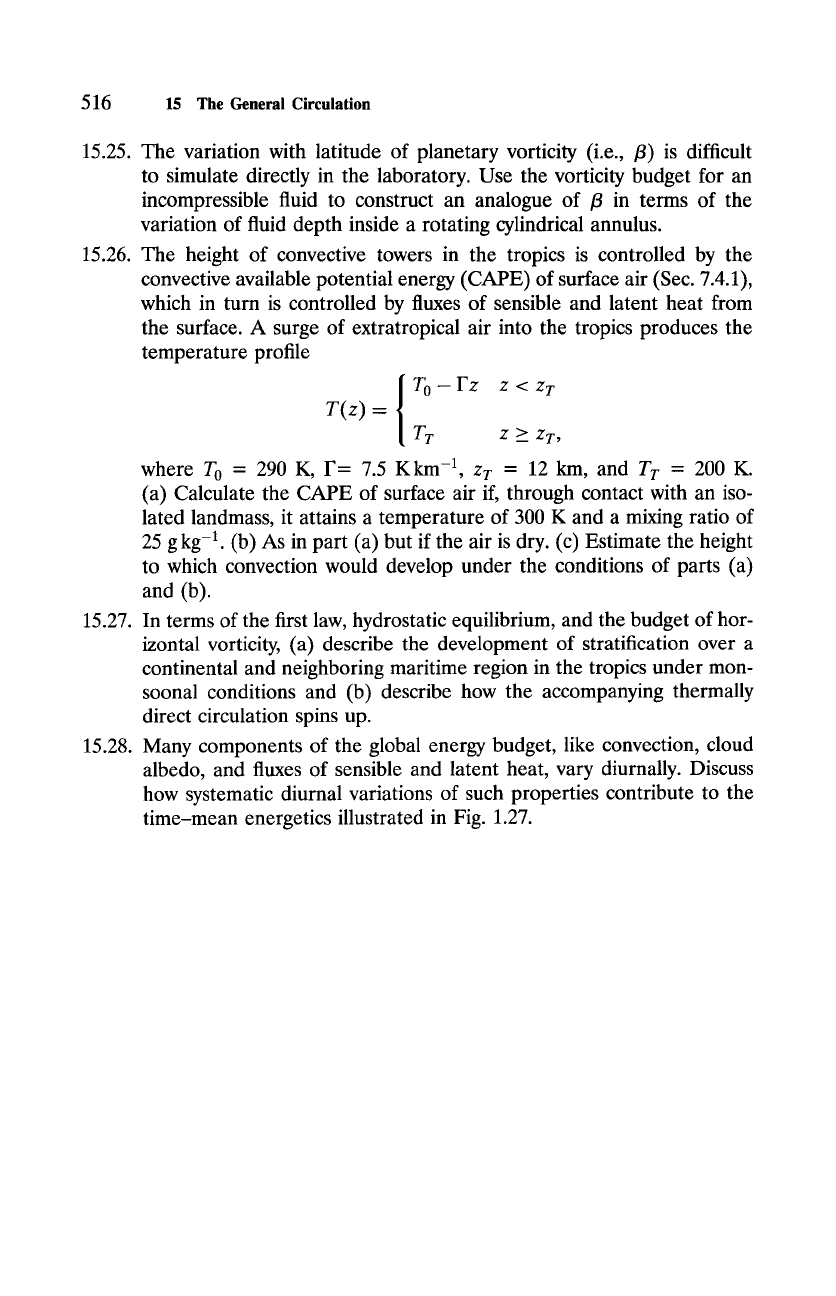
516
15
The General Circulation
15.25.
15.26.
15.27.
15.28.
The variation with latitude of planetary vorticity (i.e., /3) is difficult
to simulate directly in the laboratory. Use the vorticity budget for an
incompressible fluid to construct an analogue of /3 in terms of the
variation of fluid depth inside a rotating cylindrical annulus.
The height of convective towers in the tropics is controlled by the
convective available potential energy (CAPE) of surface air (Sec. 7.4.1),
which in turn is controlled by fluxes of sensible and latent heat from
the surface. A surge of extratropical air into the tropics produces the
temperature profile
T(z)= I T~ z < z~
I
Tr z >_ zr,
where
T o
= 290 K, F= 7.5
Kkm -1,
z T
=
12 km, and Tr = 200 K.
(a) Calculate the CAPE of surface air if, through contact with an iso-
lated landmass, it attains a temperature of 300 K and a mixing ratio of
25 g kg -~. (b) As in part (a) but if the air is dry. (c) Estimate the height
to which convection would develop under the conditions of parts (a)
and (b).
In terms of the first law, hydrostatic equilibrium, and the budget of hor-
izontal vorticity, (a) describe the development of stratification over a
continental and neighboring maritime region in the tropics under mon-
soonal conditions and (b) describe how the accompanying thermally
direct circulation spins up.
Many components of the global energy budget, like convection, cloud
albedo, and fluxes of sensible and latent heat, vary diurnally. Discuss
how systematic diurnal variations of such properties contribute to the
time-mean energetics illustrated in Fig. 1.27.
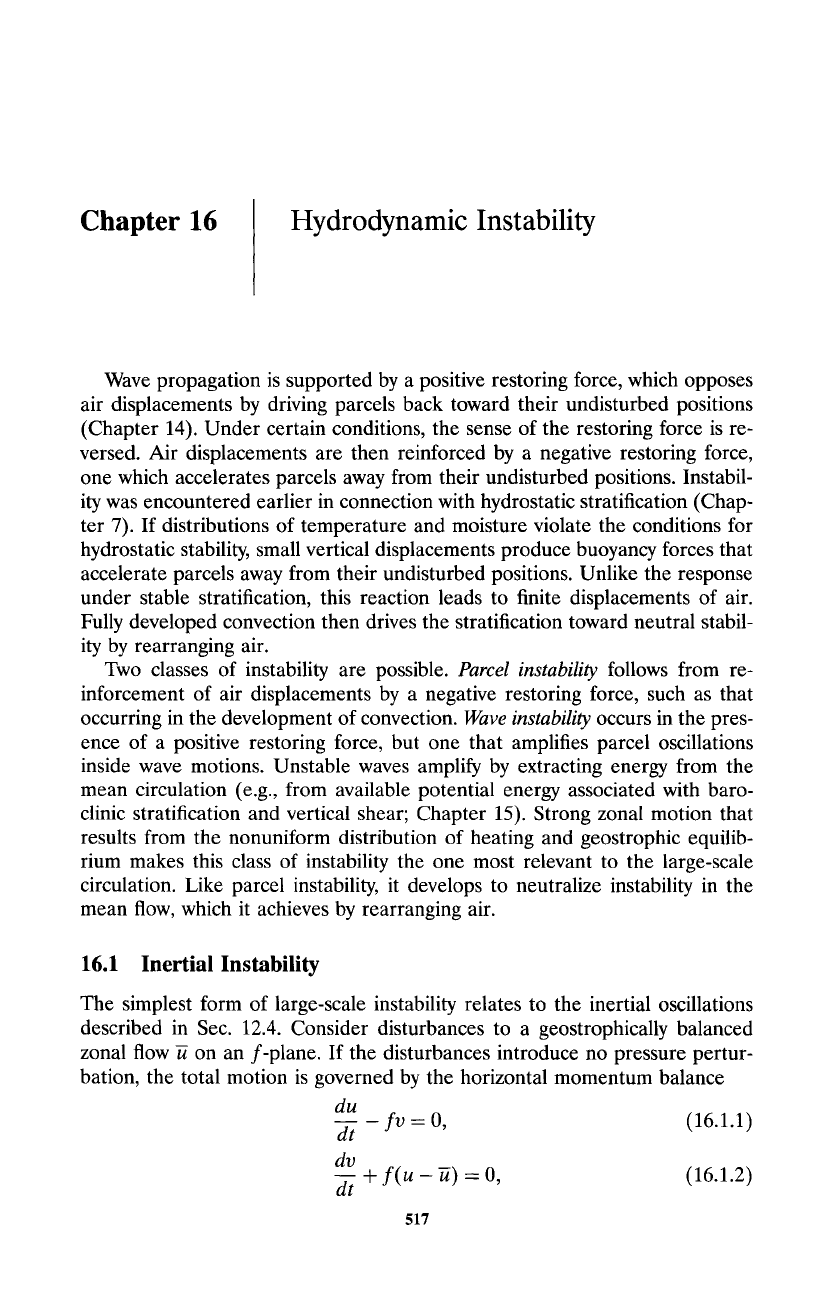
Chapter 16
Hydrodynamic Instability
Wave propagation is supported by a positive restoring force, which opposes
air displacements by driving parcels back toward their undisturbed positions
(Chapter 14). Under certain conditions, the sense of the restoring force is re-
versed. Air displacements are then reinforced by a negative restoring force,
one which accelerates parcels away from their undisturbed positions. Instabil-
ity was encountered earlier in connection with hydrostatic stratification (Chap-
ter 7). If distributions of temperature and moisture violate the conditions for
hydrostatic stability, small vertical displacements produce buoyancy forces that
accelerate parcels away from their undisturbed positions. Unlike the response
under stable stratification, this reaction leads to finite displacements of air.
Fully developed convection then drives the stratification toward neutral stabil-
ity by rearranging air.
Two classes of instability are possible.
Parcel instability
follows from re-
inforcement of air displacements by a negative restoring force, such as that
occurring in the development of convection.
Wave instability
occurs in the pres-
ence of a positive restoring force, but one that amplifies parcel oscillations
inside wave motions. Unstable waves amplify by extracting energy from the
mean circulation (e.g., from available potential energy associated with baro-
clinic stratification and vertical shear; Chapter 15). Strong zonal motion that
results from the nonuniform distribution of heating and geostrophic equilib-
rium makes this class of instability the one most relevant to the large-scale
circulation. Like parcel instability, it develops to neutralize instability in the
mean flow, which it achieves by rearranging air.
16.1 Inertial Instability
The simplest form of large-scale instability relates to the inertial oscillations
described in Sec. 12.4. Consider disturbances to a geostrophically balanced
zonal flow K on an f-plane. If the disturbances introduce no pressure pertur-
bation, the total motion is governed by the horizontal momentum balance
du
dt fv-O,
(16.1.1)
dv
dt + f(u
- ~) = 0, (16.1.2)
517
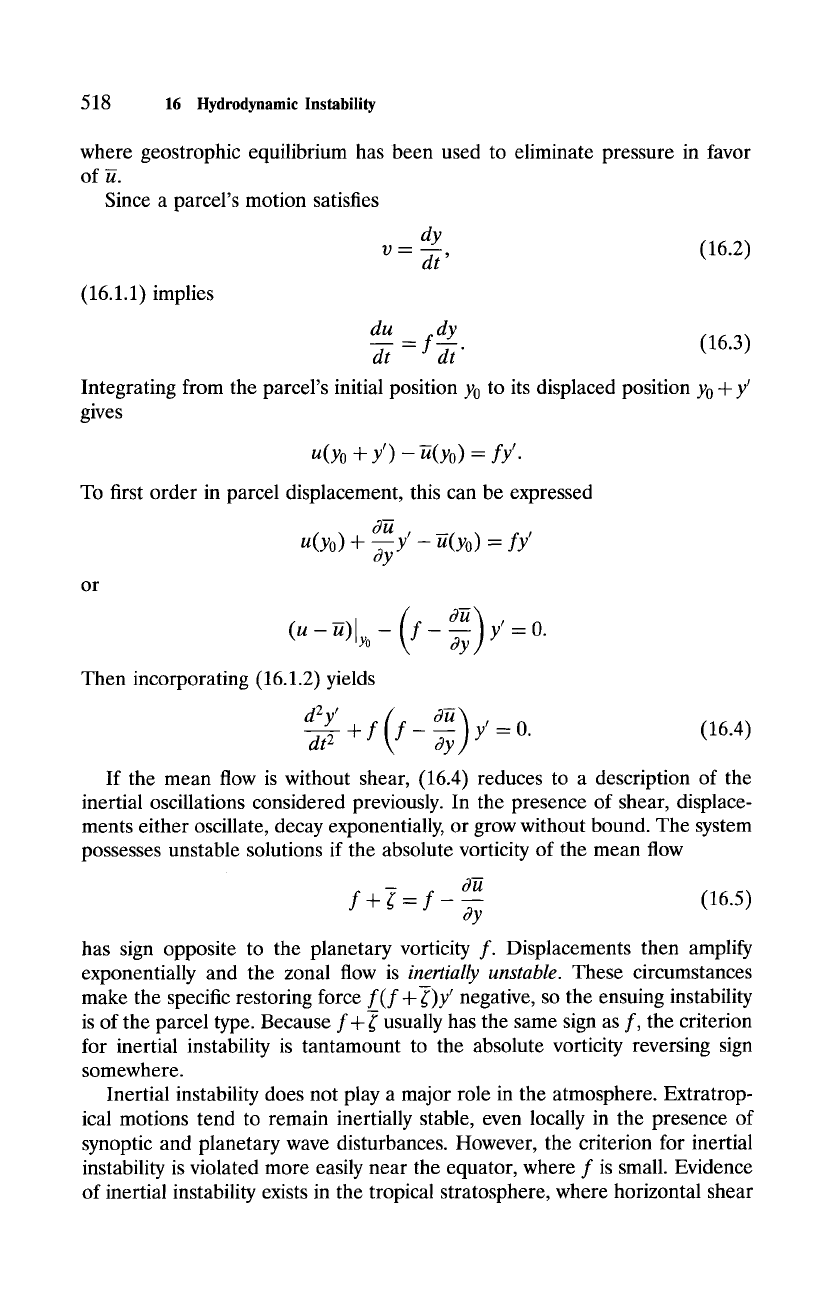
518 16 Hydrodynamic Instability
where geostrophic equilibrium has been used to eliminate pressure in favor
of ~.
Since a parcel's motion satisfies
(16.1.1) implies
dy
(16.2)
v- dt'
dt = f "
(16.3)
Integrating from the parcel's initial position Y0 to its displaced position Y0 + Y'
gives
u(yo + y') - -a(yo) = fy'.
To first order in parcel displacement, this can be expressed
d-~y,
u(Yo) + -~y - -u(yo) = fY'
or
OK) y,
(u - ~)ly0 -
f
- 7y = O.
Then incorporating (16.1.2) yields
d2y '
dK) y'
et---r + f f - Uy = o.
(16.4)
f+ st= f (16.5)
~y
has sign opposite to the planetary vorticity f. Displacements then amplify
exponentially and the zonal flow is
inertially unstable.
These circumstances
w
make the specific restoring force
f(f + ()y'
negative, so the ensuing instability
is of the parcel type. Because f + s r usually has the same sign as f, the criterion
for inertial instability is tantamount to the absolute vorticity reversing sign
somewhere.
Inertial instability does not play a major role in the atmosphere. Extratrop-
ical motions tend to remain inertially stable, even locally in the presence of
synoptic and planetary wave disturbances. However, the criterion for inertial
instability is violated more easily near the equator, where f is small. Evidence
of inertial instability exists in the tropical stratosphere, where horizontal shear
If the mean flow is without shear, (16.4) reduces to a description of the
inertial oscillations considered previously. In the presence of shear, ' displace-
ments either oscillate, decay exponentially, or grow without bound. The system
possesses unstable solutions if the absolute vorticity of the mean flow
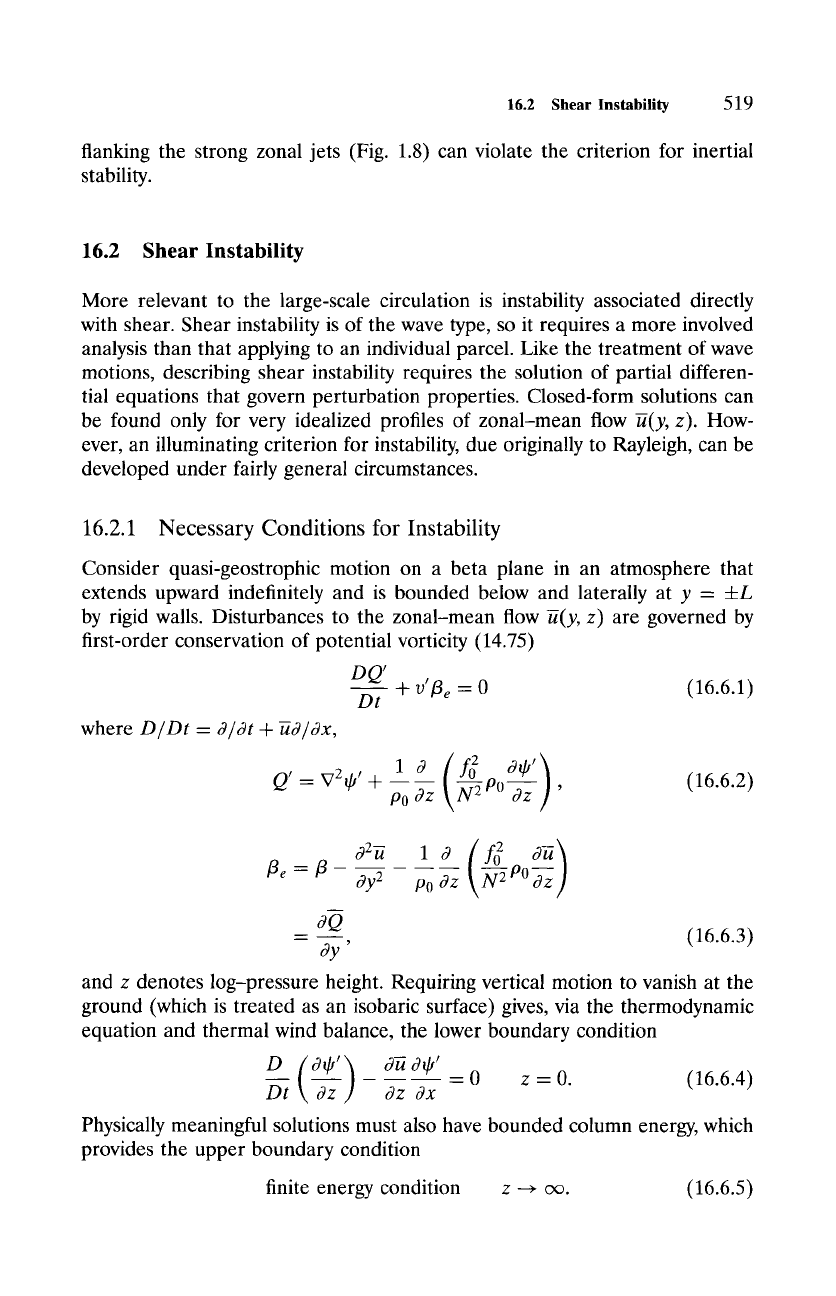
16.2
Shear Instability
519
flanking the strong zonal jets (Fig. 1.8) can violate the criterion for inertial
stability.
16.2 Shear Instability
More relevant to the large-scale circulation is instability associated directly
with shear. Shear instability is of the wave type, so it requires a more involved
analysis than that applying to an individual parcel. Like the treatment of wave
motions, describing shear instability requires the solution of partial differen-
tial equations that govern perturbation properties. Closed-form solutions can
be found only for very idealized profiles of zonal-mean flow K(y, z). How-
ever, an illuminating criterion for instability, due originally to Rayleigh, can be
developed under fairly general circumstances.
16.2.1 Necessary Conditions for Instability
Consider quasi-geostrophic motion on a beta plane in an atmosphere that
extends upward indefinitely and is bounded below and laterally at y - +L
by rigid walls. Disturbances to the zonal-mean flow K(y, z) are governed by
first-order conservation of potential vorticity (14.75)
DQ'
Dt
where
D/Dt - 3/3t + -~3/3x,
-- -]- 1)'/~ e --" 0 (16.6.1)
la (fff ,~g,')
(2'- v2q/+ (16.6.2)
po ~ ~P~ '
o~2~ 13 (f2 3~)
~e
--
~ Oy 2 PO Oz -~ Po -~z
~Q
- 3y'
(16.6.3)
and z denotes log-pressure height. Requiring vertical motion to vanish at the
ground (which is treated as an isobaric surface) gives, via the thermodynamic
equation and thermal wind balance, the lower boundary condition
=0 z-0. (16.6.4)
Dt \ 3z J 3z 3x
Physically meaningful solutions must also have bounded column energy, which
provides the upper boundary condition
finite energy condition
z ~ oo. (16.6.5)
